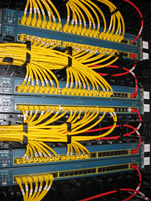
Network Equipment in BSN. |
USF Wireless Installation PolicyThere is now a new university-wide policy regarding wireless installations. Please note that there is currently relatively wide-spread, standardized wireless coverage on campus, and this coverage is constantly being increased. IntroductionThere are a multitude of affordable Wireless LAN products available, most adhering to the IEEE 802.11 standards (a, b or g). Setting up a basic Wireless LAN (WLAN) using these products is very simple and offers great flexibility in mobile computing. Although these devices work just fine in a home or small office, most of them aren't well suited for a campus-wide environment. Data Network Management at USF is responsible for the proper operation of the network. That is why any wireless (or any other network devices) connected to USF's data network must approved for interoperability and remote management capabilities that allow for troubleshooting. Wireless installations also need to take into account fire, electric and building codes, radio propagation, avoiding interference and conforming to a campus-wide USF standard. There have, in fact, been multiple cases in which users have connected unapproved devices to the USF network and brought down entire network segments before they were caught. Don't become one of them! How to Avoid ProblemsPlease contact Information Technology Communications before purchasing equipment. We will be happy to help you design the best possible solution. Also, see the official campus standard on wireless devices. Please note that the equipment we specify may be rated for plenum air spaces, has advanced management capabilities, significantly better radio performance than consumer units and typically uses high-gain external antennas, and consequently will be more expensive than your typical consumer device. Feh. I Still Want to Install My Own!
If you have any suggestions, experiences you would like to share, or questions, please feel free to contact Information Technology Communications at help@usf.edu. |
